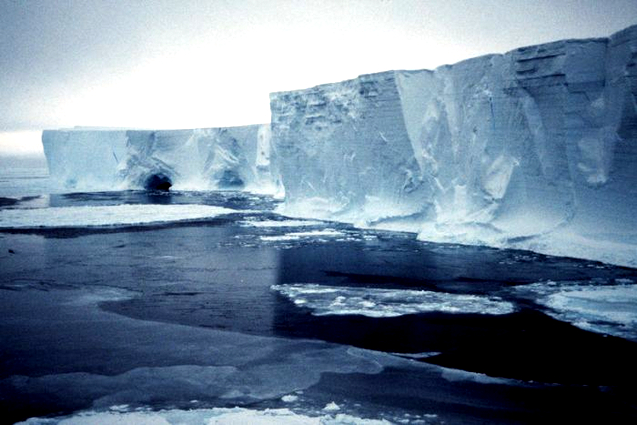 |
| Climate change is a financial risk companies are starting to prepare for. (Australian Antarctic Division) |
On Wednesday, Australia's largest coal miner, Glencore, joined a growing list of global companies that have succumbed to shareholder pressure to act on climate change.
The Swiss-based resources giant, headed by billionaire Ivan Glasenberg, recognised there is a business case for freezing its global coal production at current levels.
It said it would instead shift focus to producing commodities including copper, cobalt, nickel, vanadium and zinc.
The announcement was made after the company held talks with the Climate Action 100+ initiative, whose global members collectively manage more than $US32 trillion in assets.The group includes a number of major Australian superannuation funds such as AMP Capital, AustralianSuper, Cbus, IFM Investors, QSuper and BT Financial Group.
It's shown it has sway when it comes to pressuring companies to implement changes aimed at achieving the goals of the Paris climate agreement.
In recent months the group has worked with other companies, including Shell, BP and Maersk, and convinced them to take steps that show they are serious about meeting the Paris climate agreement goals.
Emma Herd, chief executive of the Investor Group on Climate Change and member of the global Steering Committee for the Climate Action 100+, said the change in sentiment was because of greater recognition by CEOs that climate change is not just an ethical issue.
"This is about financial risk, as well a company's social licence to operate," she said.
"Super funds were first onto the issue because they take a 30-year investment horizon. These are very big mainstream funds asking very big mainstream companies to have a business plan on climate change."
Climate change-related litigation is no longer a joke.
Regulators are weighing in as the prospect of lawsuits becomes more realistic.In a speech in June, ASIC Commissioner John Price said directors "would do well" to carefully consider a 2016 legal opinion by Noel Hutley SC and Sebastien Hartford-Davis that they could face lawsuits for failing to consider risks related to climate change.
Meanwhile, the Australian Prudential Regulation Authority (APRA) has been pushing ASX200 companies to run "stress tests" on potential climate risk scenarios.
In November, 2017 APRA executive Geoff Summerhayes warned that "should extreme weather events become more frequent and intense as scientists predict", there could be "adverse economic impacts" that threaten financial system stability.
That same year, Melbourne law practice Environmental Justice Australia had launched a case arguing the Commonwealth Bank had breached corporate law by not disclosing climate change as a major or material risk in its annual report.
The case was dropped when the bank subsequently disclosed climate risk in its annual report.
In July last year Industry super fund REST — the default industry super fund for many retail workers — faced a federal court legal battle over claims it breached its trustee duties by failing to properly factor climate change-related risks into its investment decisions.
Mark McVeigh, a 23-year-old ecology graduate, took on the legal case against the super fund, accusing it of breaching superannuation law by failing to act in his best interests.
Then in October, the New York Attorney-General's office sued ExxonMobil, accusing the fossil fuel giant of defrauding investors by misleading them about the financial risks the company faced from climate change regulations.
Oil giant Shell was first threatened with a lawsuit last year by the Dutch branch of Friends of the Earth. Greenpeace, ActionAid and other groups have now joined in, accusing Shell of "deliberately obstructing" efforts to keep global warming well below 2 degrees Celsius.
They have threatened they will move to a court summons on April 5 if Shell does not change its business model to comply with the Paris climate accord.
A study released on Monday by environmental campaign group Market Forces found just 14 per cent of Australia's top 100 companies have disclosed detailed scenario analysis demonstrating their viability in a 2-degree policy pathway.
As investors, regulators and litigators continue to exert pressure, it's only a matter of time before companies act.
Links
- Glencore moves to cap global coal output after investor pressure on climate change
- Australia's biggest companies ignore climate change risk: report
- Mark wants to know if his super is protected from climate change. So he's taking his fund to court
- Commonwealth Bank faces legal action over failure to disclose climate change risk
- These Residents Stopped A Coal Mine, Made History And Sent Ripples Through Boardrooms Around The World
- Australia's Coal Future Under Threat As More Changes Hit Fossil Fuels Globally
- As Lawsuits Over Climate Change Heat Up, Oil Industry Steps Up Attacks On Its Critics
- Coal Miners Derided Climate Action 'Sideshow'. Now It's The Main Event
- 'We Won': Landmark Climate Ruling As NSW Court Rejects Coal Mine
- See You In Court, Citizens Tell Governments On Climate Change
- A Surge Of Climate Lawsuits Targets Human Rights, Damage From Fossil Fuels







